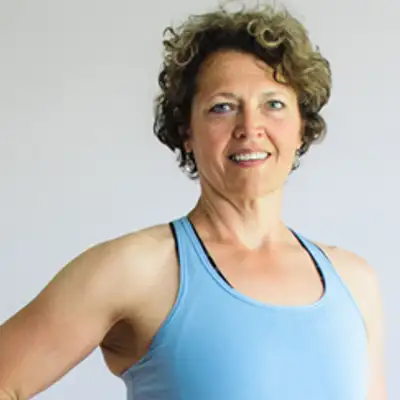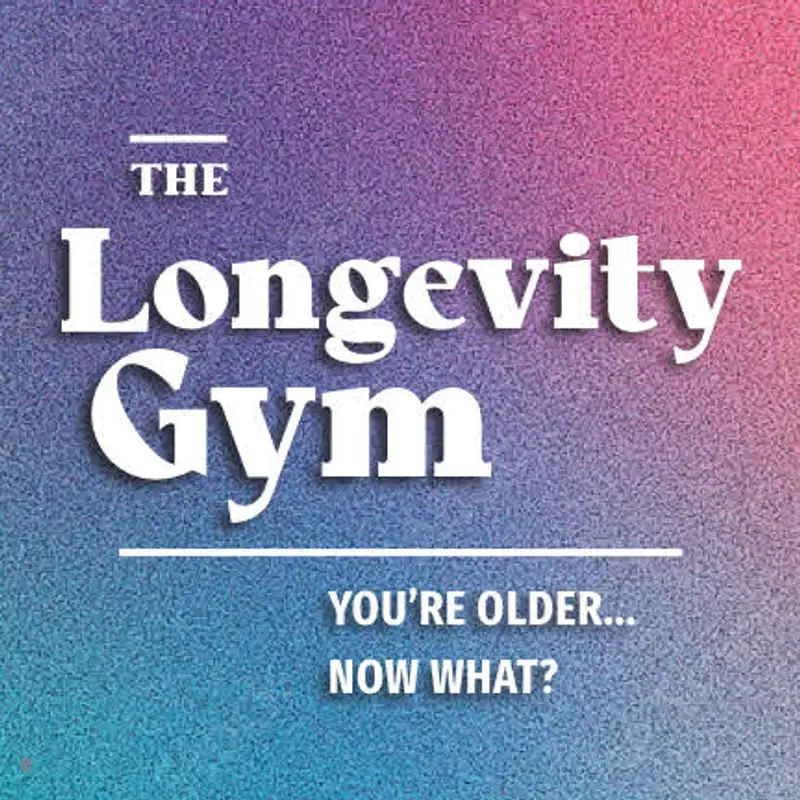Here's a guided breath awareness session for you
Download MP3Pam Strand: Hello, my name is Pam Strand.
I'm your podcast host, and I would like
to welcome you to the Longevity Gym.
The Longevity Gym podcast is devoted
to helping you stay strong and
healthy as your body ages, so you can
live longer, stronger, and better.
Today's episode is a continuation of the
conversation we started in the previous
episode, number 18, about breathing,
about how nasal and diaphragmatic
breathing is the healthiest, breathing
pattern for everyday life while we
are awake and while we are sleeping.
If you haven't already, you will
want to listen to episode 18 is that
discussion is just a nice introduction
to nasal diaphragmatic breathing.
That's the healthiest way to breathe.
Science is showing in today's episode,
I share a guided breath awareness
session that I created as a means for
getting to know your breath and for
helping you to discover where and how
you might make the shift towards nasal.
Diaphragmatic breathing.
This episode is one you can listen to
often as there is always something new
to be discovered about your breath.
Plus it's a great stress buster.
It will help you relax.
The session is best done
sitting or laying down.
You can use a chair or cushion if you want
to sit either way, find a space where you
can safely close your eyes if you want
to and where you will not be interrupted.
Before you get started, I want
to provide some safety guidance.
While breathwork is a very safe
modality, you should check with your
medical provider to see if it is safe
and healthy for you, especially if you
have any respiratory issues or diseases,
epilepsy, mental health challenges.
And if you are pregnant , it's important
to check in with your doctors for some
breathing techniques are recommended
and others are not follow what you
know is safe and healthy for your body.
I hope you find this
guided session helpful.
If you have any questions,
be sure to email me.
My email is Pam at strandfitnessonline.
com.
My email address is also
in the show notes below.
So without further ado,
here is the guided session.
Enjoy.
Welcome to this breath awareness session.
Today we're just going to spend a few
moments connecting with our breath and
observing what that experience is like.
A breath awareness session is a great
way to bring some relaxation into your
body and to rejuvenate your energy.
In fact, the mere act of spending
a few moments observing your
breath does a lot for relieving
stress and renewing your energy.
So I invite you to find your comfortable
position, whether that's seated on a
cushion on the floor, or in a chair,
or laying on the floor, wherever you're
comfortable, and wherever you will not
be interrupted for the next few moments.
If you're in a chair, Make sure you
can sit comfortably with the back
of the chair supporting your back.
If you're sitting on the floor, on a
cushion, make sure you're up against
a piece of furniture or a wall,
just again to support your back.
If you're on the floor, I invite you
to bend your knees and place your
feet flat on the floor and let your
arms fall to your side, palms up.
If you're in a seated position,
gently rest your hands in
your lap or on your thighs.
Just soften a little bit.
And relax, but not so
much to invite sleep.
Just want to be able to be calm.
No stress, no strain on the body here.
Wiggle around a little bit to find your
resting spot for the next several moments.
If you haven't already, close your
eyes if that's comfortable for you.
If not, just have a soft gaze.
Breathe in and out through your
nose if that's comfortable.
And if it's not, it's just fine to be
breathing in and out through your mouth.
Relax your jaw, relax your eyes,
your eye sockets, your eyelids.
Maybe if you're still squinting
as if you're sitting under
the, looking at your computer.
Just relax the eyes, relax the ears.
Let your tongue move to the roof
of your mouth, to the soft palate.
See if you can't create a little suction
there so the belly of your tongue is
up against the roof of your mouth.
If you're breathing through your
mouth, you may not be able to do
this, so you'd want to let your tongue
just rest at the bottom of your jaw
and just notice your breath.
If at any time your mind wanders
away from the breath, don't worry.
Just bring it right back.
No judgment, no need to criticize
yourself for letting your mind
wander because your mind wanders.
It's just what it does.
So bring the mind back and tune
your attention to your breath.
And let's focus on what it feels like
breathing in and out through your
nose, or if you're breathing through
your mouth, what it feels like to
breathe in and out through your mouth.
What is, what's that sensation like?
Do you notice any difference
in the temperature when you
inhale versus your exhale?
Do you notice any muscles
tensing on your inhale?
Any facial muscles?
If so, see if you can relax them
and keep them soft as you breathe,
in and out through the nose,
in and out through the mouth.
Just notice what that sensation is.
And then let's move to the throat.
Can you feel your breath in
and out through your throat?
Try relaxing your throat, your neck,
maybe bringing your throat to the
back of your neck if that makes sense.
And just feel what it feels like
to have the air flowing in and out.
up and down your throat.
Again, if your mind has wandered,
bring it back to the sensation of the
air, moving up and down your throat.
And now if you would like, place one
hand on your chest, right in the middle
of your chest, and the other hand just
a little bit below your belly button.
And let's follow the breath.
So it moves from your
throat into your lungs.
And as it does that, what's
the movement in your torso?
Do you feel the movement?
Is your chest moving?
Is your belly moving?
Or maybe a little of both?
And what's your breath like?
Is it moving kind of quickly?
Or is it slow?
Are you breathing somewhat shallow?
Lightly,
or you have a deep,
strong breath going on.
Either one is fine, we're
just noticing right now.
So leaving your hands on your chest
and on your abdomen, just go back
up to your face and your throat.
Has tension eased back in
or eased into those areas?
If so, relax them.
So we're going to envision our diaphragm.
That's the major muscle for bringing our
breath in and pushing our breath out.
And the diaphragm sits right underneath
the curve of the ribs, right below the
sternum, that V shape, that inverted V.
Diaphragm's tucked up in
there when it's relaxed.
And when you inhale, your diaphragm
expands, almost like a sphere shape.
Take the hand that's on your belly and
move it up into that V on the ribs.
Again, what's moving most here?
Is it your chest?
Is it your belly?
Now let's see if we can
Focus on the diaphragm.
And notice, as you inhale, the breath
really starts in the diaphragm.
It's pulling the air in.
Maybe you can feel that timing, the
belly expanding as the diaphragm expands.
And then in the next instant,
you may feel the air coming in
through your mouth or your nose.
See if you can sense that.
And
on the way out, the diaphragm
relaxes, pushes the air out.
So you may feel your chest or your belly.
Relaxing or falling.
Again, in the next moment, you
might feel the warm air coming
out your mouth or your nose.
Go ahead and release your hands.
If you're seated, bring
them back to your lap.
If you're laying down, bring
them back to your side.
Continuing to be aware of your breath
and what that sensation is in your body.
Wherever you want to focus,
focus your attention there.
And then I want to see if you can turn the
control of your breath over to the body.
Just relax.
And let the body breathe on its own.
And you are just the observer.
You're the one going along for the ride.
What is this sensation like?
To let the body breathe the way it wants
to breathe, and way it needs to breathe.
And as we come to the end of
this awareness session, just
want you to do a brief scan.
What does it feel like on the inside?
What have you created here?
What has your breath created here for you?
If the experience isn't
extremely positive, that's okay.
Just sit with it.
Be patient.
If you notice a positive feeling on the
inside, just savor that for a moment.
And on your next inhale, inhale
some movement into the body.
Wiggling your hands,
your fingers, your toes.
Maybe gently contracting
and releasing some muscles.
Just notice when you do that,
what happens to the breath.
And where the mind goes.
Is the mind here still
watching your breath?
Feeling the movement that you're
bringing back into your body?
Let's just take a nice, slow inhale.
And when you need to,
take a nice, slow exhale.
Nice and slow.
Let's do that one more time.
A nice, slow, long inhale.
And a nice, slow, long exhale.
And when you're ready,
gently open up your eyes.
And may peace be with you
for the remainder of the day.
Creators and Guests


